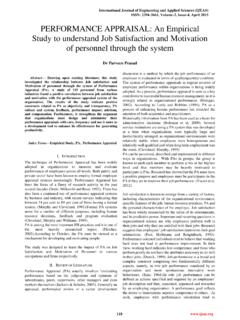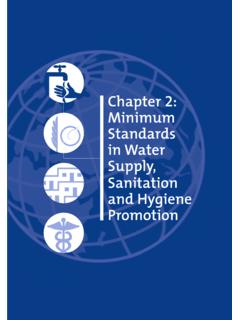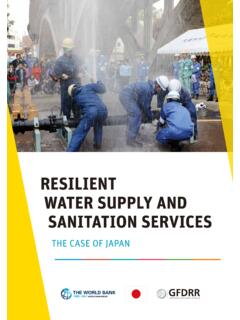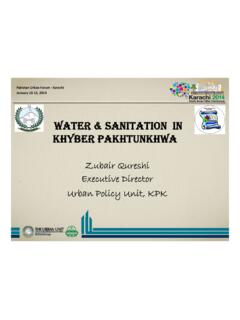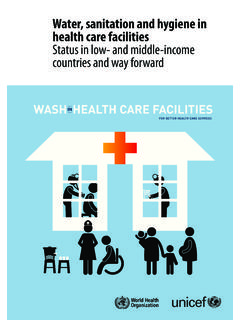Transcription of Water Supply and Sanitation Challenges in an Urban Setting ...
1 International Journal of Engineering and Applied Sciences (IJEAS). ISSN: 2394-3661, Volume-1, Issue-3, December 2014. Water Supply and Sanitation Challenges in an Urban Setting : A Case Study David O. Olukanni, Michael O. Ajetomobi, Samson O. Tebowei, Olakunle O. Ologun, Oluwasanmi M. Kayode national progress in extending access to safe Water and Abstract Access to clean Water , good Sanitation services Sanitation (WHO/UNICEF, 2012). Using data collected by and improved hygiene practices enhance sound health, boost national statistics offices and other relevant institutions socio-cultural development, and promote economic balance. through household surveys and censuses, the WHO/UNICEF. This study is focused on investigating and identifying the state of Joint Monitoring Programme for Water Supply and Sanitation Water , Sanitation and hygiene practices in an Urban Setting , and proffer solutions to the probable Challenges associated with it.
2 (JMP) estimates progress alongside the MDG target Five Local Government areas (LGAs) of Lagos State were (UNESCO 2009; WHO/UNICEF, 2012). Over 600 surveys selected for this study. The survey involved the use of structured and censuses were used, including the USAID Demographic questionnaires administered to randomly selected residents and Health Surveys (DHS) and the UNICEF Multiple from the LGAs. The Statistical Package for Social Sciences Indicator Cluster Surveys (MICS) (Cairncross et al., 2006). (SPSS) software application and descriptive statistics were used Globally, it has been observed that poor Sanitation has been for data analysis. The study reveals that access to Water and a major challenge to development, education, gender equality, proper Sanitation is insufficient and its services is at high cost to social-economic development and progress on health in many many of the residents who live below the poverty line of less than $2 per day.
3 The Supply of Water from the Water corporation to developing countries (UNICEF/WHO 2012). In the African the local government is not sufficient thereby making many to Continents, the issue of Water and Sanitation has not been any rely on commercial and private boreholes which often time is different. In the year 2000, it was noted that one-sixth ( expensive. The result also shows that indifferent attitude billion people) of the population in Asia and Africa did not characterizes poor Sanitation which is basically associated with have access to improved and treated Water Supply , and two poor maintenance, indiscriminate dumping of refuse in drains fifth ( billion people) did not have access to improved and ineffective drainage systems. It is therefore important that Sanitation . Africa is known to have the lowest Water Supply sustained cooperation be developed among key actors in order to coverage of the global regions (Africa, Asia Latin America reduce cost of gaining access to potable Water .)
4 There should also be continuous sensitization and enlightenment campaigns to the and the Caribbean, Oceania, Europe, and North America) and public on the dangers of environmental neglect. is second to Asia in terms of lowest Sanitation coverage (UNESCO, 2009; UNICEF/WHO, 2012). Index Terms Hygiene, Local Governments, Lagos State, In Africa, 2% of the total population have access to Sanitation , Urban Setting , Water Supply . improved Water Supply and 60% have access to improved Sanitation , but the situation in the rural area is worse with only I. INTRODUCTION 47% of their population having access to improved Supply The provision of potable Water Supply and good Sanitation and 45% having access to improved Sanitation services at a reasonable and affordable cost is the first step in (WHO/UNICEF, 2000). According to the report by eliminating poverty.
5 These have been established to improve UNICEF/WHO (2012), coverage rate in 2010 was lower than health, boost socio-cultural development, and promote the rate in 1990 and below 10% of the 2010 rate required to economic balance (Okun, 1988; Bendahmane 1993; Olukanni, meet the target in the sub Saharan Africa. In 2010, an estimate 2013; Olukanni et al., 2014a). More so, it is known to be the of 66 million Nigerians were without access to an improved basic primary drivers of public health, personal hygiene and drinking Water source. This makes Nigeria one of the ten human dignity (WHO/UNICEF, 2000). The Millennium countries in the world with the largest population without Development Goal (MDG) target for Water and Sanitation access to an improved drinking Water source. This is as a provides a useful framework to monitor global, regional and result of increase in population which is not directly proportional to the facilities provided for Water Supply and Sanitation compared to those in India and China.
6 Dr. David O. Olukanni, Department of Civil Engineering, College of As the MDG target year is closer, it is unimaginable that less Engineering, Covenant University, Ota, Ogun State, Nigeria. than 50 percent coverage in potable Water Supply and access +234-8030726472, Messrs. Michael O. Ajetomobi; Samson O. Tebowei; Olakunle O. to basic Sanitation are still evident in sub-Saharan Africa with Ologun; Oluwasanmi M. Kayode, are all graduates of Civil Engineering, no exception to Nigeria. In Nigeria, access to clean Water and Class of 2014, Covenant University, Ota, Ogun State, Nigeria. proper Sanitation is a major challenge. Water and Sanitation . 34 Water Supply and Sanitation Challenges in an Urban Setting : A Case Study coverage rates in Nigeria are amongst the lowest in the world million out of 69 million people residing in Urban areas had (WSMP NIGERIA, 2008).
7 According to a report by the access to improved Sanitation services (Sari and Ari, 2006;. WSMP (2008), Nigeria is currently not on track to reach the WSMP NIGERIA, 2008). Sanitation in Nigeria is also MDG targets of 75% coverage for improved drinking Water following a negative trend, which has led to slow progress in and 63% coverage for improved Sanitation by the year 2015. the aspect of proper Sanitation . Figure 1 shows a regression Also, the proportion of the Urban population with access to line of the current status of Water and Sanitation in Nigeria. It improved sources of drinking Water in Nigeria decreased by implies that Nigeria is not on track with the MDG target on 15% from 80% in 1990 to 65% in 2006. The reduction by safe Water and basic Sanitation . 15% in 16 years is very important at a time that the proportion of the population living in Urban areas increased from 30% in 1990 to 49% in 2006.
8 The Sanitation sector has not been doing well also, because the number of people with access to improved Sanitation services in Urban areas in 1990 was 6. million out of 26 million people in Urban areas. In 2006, 24. Fig. 1 Current Status of Water and Sanitation in Nigeria Source: JMP 2008. Generally in Lagos State, a highly dense populated state, the challenge with Water Supply and Sanitation are prominent issues that are yet to be completely solved by the government. Lagos State being the social and commercial hub of the nation with increasing population of over 20 million (making it about 12 percent of Nigeria's population) is the focus of this study. Most residents of the State have problems accessing potable Water and proper Sanitation due to the high cost that has been placed on them by the government or private scheme. Therefore, the aim of this study is to determine the service levels, cost of Water and Sanitation in the State.
9 Fig. 2 Map of Lagos State showing the Selected Locations Five (5) Local Government Areas (LGAs) in the State were II. METHODOLOGY. selected. These are Mushin, Alimosho, Ikeja, Agege, and The Study Area Ifako-Ijaye which are closely linked together as shown in Lagos State lies between the sedimentary belt of Figure 2 of the State Map. This serves as a reflection of the South-Western Nigeria on longitude 2o 45'E and 4o 20'E and happenings in other LGAs. Data collection was carried out in latitude 6o 2' N and 6o 4' N. It is the most urbanized State and five (5) weeks in the months of February through March, 2014. its cities are ranked amongst the major growing cities in with the use of questionnaires and interview. A. Nigeria (Mabogunje, 2002). It has a land area of well-structured questionnaire was distributed to 250 persons and population density of persons per km2 (Source: spread across the selected five (5) Local Government areas.)
10 The descriptive cross-sectional study identified 50. Surveyor-General Office Secretariat, Ikeja) and has a respondents from each location through careful selection. population of about 17,552,942 (Census, 2006). Fig. 2 shows Interviews with the residents, observation and focus group the map of the study area with the selected locations. 35 International Journal of Engineering and Applied Sciences (IJEAS). ISSN: 2394-3661, Volume-1, Issue-3, December 2014. discussions were also adopted in capturing data and people in selected location buy Water 3 times a week and 12. information. The questionnaire covers personal data, Water times a month which cost about N200 (less than $2) to buy a quality, Water availability, faecal disposal and hygiene cart of non potable Water that last for 2 days, $24 in a month promotion in the immediate environment.


